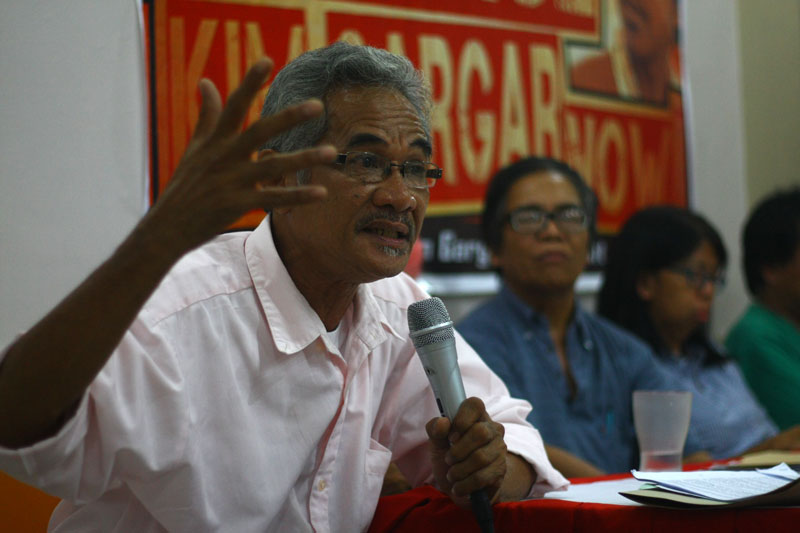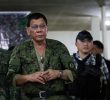
Francis Morales of Balsa Mindanao explains that the research of jailed scientist Kim Gargar would guide in them on how to rehabilate Pablo ravaged areas. (davaotoday.com)
Davao City – The research study by University of the Philippines physicist, Kim Gargar, is supposed to guide a disaster response group on the how to rehabilitate certain Typhoon Pablo ravaged areas in Compostela Valley, a private welfare group said.
Francis Morales, coordinator of Balsa Mindanao (Bulig Alang sa Mindanao or Help Mindanao) People’s Mobilization for Disaster Response and Climate Justice, said “the bigger plan of Balsa Mindanao of a sustainable agriculture intervention for Pablo victims, a 3-year implementable proposal with big organizations, would be based on the result of Kim’s research”.
“Kim went here because of the insistence of Balsa Mindanao to involve scientist in crafting possible interventions with the great extent of damage of Pablo,” Morales told a press conference Thursday.
Morales said that after consultations with Kim they were able to create a proposal approved by Ateneo de Davao University.
“We implemented it and was able to plant a total of 61 hectares of crops, 50 hectares of upland rice and 11 hectares of corn now ready for harvest and consumption of Pablo victims in the area,” Morales said.
He said that part of their sustainable agriculture program is the creation of seedling nurseries, giving food subsidy to Pablo victims who will participate, policy and issue advocacy and provision of farm implements.
The Eastern Mindanao Command, in a statement, said however, that troops found Gargar unconscious “while clutching a rifle 200 meters away from the encounter site” between government forces and members of the New People’s Army in Barangay Aliwagwag, Cateel, Davao Oriental.
The statement said that “Gargar was captured by troops who were pursuing the rebels” after the firefight and that he “joined the NPAs in Compostela Valley Province in 2012.”
The miltary statement also alleged that “landmines and subversive documents were recovered” from Kim.
But, Kim’s mother Elizabeth could not believe such claims of the military.
“Di ko makatoo anang ilang pasangil. Kato si Kim makapas-an anang gibutang-butang nga mga armas man kaha na, makapas-ana ilakaw-lakaw didto sa bukid? Dili gyud! (I could not believe their accusations. Kim would be able to carry those heavy firearms and roam the mountains? No, never!,” said Elizabeth.
“We cannot imagine that our son will do that, even fireworks scare him and now (they say) he brings (a firearm)? We could not believe that and what they say that he fell but when he was found, he was clutching an M16? It is not believable. When you fall what you hold in your hands is thrown away,” said Kim’s father, Emmanuel.
Elizabeth said Kim not the type who always goes out and play. “He’d rather pick-up a book and study,” she said.
Since high school, Kim, their fourth child, has been an academic scholar. “He entered college as a DOST (Department of Science and Technology) scholar. He survived all his studies because he receives allowance. He even has enough to go around wherever he wants,” Elizabeth said.
Frances Quimpo, Kim’s former colleague in the environmental group Center for Environmental Concerns based in Manila said Kim “only arrived in the Philippines December 2012”.
“We asked his friends from The Netherland to share with us photos and other things which can help prove that Kim is indeed studying there. One even sent a copy of his university student registration,” Quimpo said.
He said that she convinced Kim to be part of their organization last February but she said it only took several months for him to decide to respond to the call of rehabilitation of Pablo areas.
“He hails from Iligan and he was in The Netherlands when typhoon Sendong happened. Since he only returned to the country December 2012 he was not also able to immediately work after typhoon Pablo struck. His art is aching because of that,” Quimpo said.
Morales said he and his colleagues could not help but suspect that the “intention of the military in vilifying the image of Kim is to justify their presence in the area”.
“The 61 hectares of crops are now bowing (ripe for harvest) but all of it got destroyed because the military gisiging-siging (harassed the) communities,” he said.
Morales cited the recent evacuation of tribal and farmer residents in Barangay Mangayon, Compostela in Compostela province.
The area is where Balsa implemented sustainable agriculture with the help of the Ateneo de Davao University, Redemptorist Brothers and Masipag Mindanao.
Morales said that the “military harassment occurred in the area because of the incursion of a mining company, which was opposed by the residents-typhoon victims”.
“The result of the latest fact-finding mission [sent to Mangayon] revealed that three retail stores were ransacked, a water hose which we helped provide was hacked, a house was strafed with bullets and three kids who were supposed to bring rice to workers building a lumad school were beaten by the soldiers,” Morales said.
For Morales, Quimpo and Kim’s parents, what the military has done will only derail the ongoing efforts by removing Kim from the picture.
“We will never give-up Kim’s case as his freedom means his return to the efforts in helping people recover from the ravage of typhoon Pablo,” said Quimpo.
“The government should withdraw the charges so that Kim can go back to the good work he has been doing,”Kim’s father Emmanuel .
Myfel Paluga, a teacher at the University of the Philippines in Mindanao said “we should protect Kim as a true people’s scientist and ignoring such would discourage other scientist in becoming one”. (John Rizle L. Saligumba/davaotoday.com)
compostela valley, davao oriental, Indigenous Peoples, mining, typhoon Bopha, typhoon Pablo, typhoon sendong








